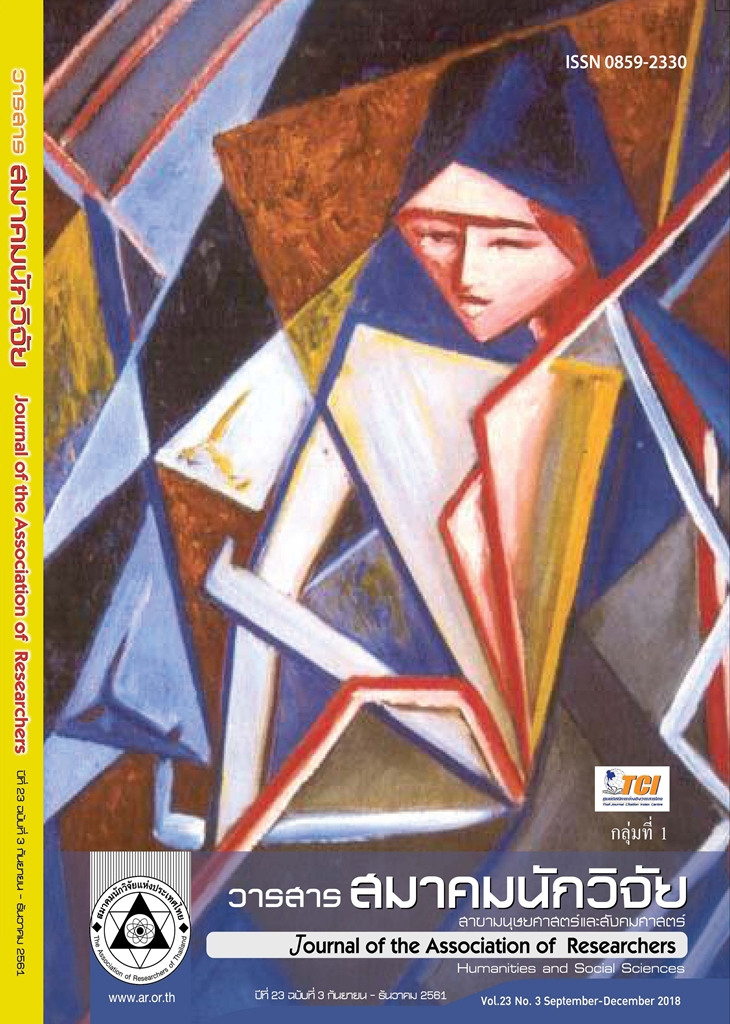Technology innovation and system quality affect the effectiveness of digital Marketing in Thailand 4.0 of Internet online Business
Main Article Content
Abstract
Study of technological innovation and system quality affecting the effectiveness of digital marketing in Thailand 4.0 In the Internet trading group, the objectives are 1) to study the strategic factors, technology innovation and the quality of digital marketing system in Thailand. 2) to study the effectiveness of digital marketing in Thailand 4.0 in the Internet trading and 3) to study the model of structural equation, innovation, technology and quality of the system. Effect on the effectiveness of digital marketing in Thailand 4.0 the research method was quantitative research. The number of Internet merchants. 500 samples, inferential statistics, categorical analysis (CFA), structural equation analysis (SEM) Correlation Coefficient of Chi-Square Value 176.197 / df = 147.0 / sig. = 0.051 / CMIN / df. = 1.199 / CFI = 0.975 / GFI = 0.931 / IFI = 0.992 / NFI = 0.992 / AGFI = 0.931 / RMSEA = 0.020 /RMR=0.008 All indices were statistically significant. The research found that the factors that positively influenced the effectiveness of digital marketing in Thailand 4.0 were the following: the diffusion of technological innovation of the organization, the communication process, the innovation, the technology, the characteristics, the innovation, the technology, the organization and the decision-making process. Influence indirectly on the effectiveness of digital marketing in Thailand 4.0 It was found that factors influenced by the spread of innovative technology, technological innovation, technology innovation, organizational innovation, technology quality, technological innovation. The technology is the communication process, the innovation, the technology, and the technology. In addition, the indirect positive influence factors on the effectiveness of digital marketing in Thailand 4.0 through the spread of technological innovation and the decision-making process of using the highest technology innovations were quality, innovation and technology. In addition, the research found that factors that directly influence the spread of technological innovation. Organization is the highest Quality, innovation, technology, and factors that directly influence the decision-making process utilize the highest technological innovation, ie, innovation, technology, organization, quality, innovation, technology, and technology diffusion. Positive to the decision-making process using technology innovation.
Article Details
บทความที่ปรากฏในวารสารนี้ เป็นความรับผิดชอบของผู้เขียน ซึ่งสมาคมนักวิจัยไม่จำเป็นต้องเห็นด้วยเสมอไป การนำเสนอผลงานวิจัยและบทความในวารสารนี้ไปเผยแพร่สามารถกระทำได้ โดยระบุแหล่งอ้างอิงจาก "วารสารสมาคมนักวิจัย"
References
Baumgartner, H., & Hombur, C. (1996). Applications of structural equation modeling in marketing and consumer research. International Journal of Research in Marketing, 13.
Bentler, P. M., & Bonett, D. G. (1980). Significance tests and goodness of fit in the analysis of covariance structures. Psychological Bulletin, 88, 588-606.
Bollen, K.A. .(1989). Structural equations with latent variables. New York: John Wiley & Sons. Browne, M.W. and R. Cudeck .(1993). Alternative ways of assessing model fit, in TestingStructural Equation Models,. S., Newbury Park CA: Sage, 136-162.
Cochran, W.G. (1953). Sampling Techiques. New York : John Wiley & Sons. Inc.
Diamantopoulos, A. & Siguaw, J.A. .(2000). Introduction to LISREL: A guide for the uninitiated. London: SAGE Publications, Inc. Drucker,P.F. 1985, “The Discipline of Innovation”. Harvard Business Review. Vol. 68, no. 4, pp. 67-72.
Durande-Moreau, A. & Usunier, J. (1999). “Time Styles and the Waiting Experience: An Exploratory Study”, Journal of Service Research, vol. 2, no. 2, pp. 173-186.
Gurteen D. (1998). “Knowledge , Creativity and Innovation”. Journal of Knowledge Management. Vol. 2, no. 1, pp. 5-13.
Hair, J. F. J., Anderson, R. E., Tatham, R. L., Black , W. C., 2006. Multivariate Data Analysis (Sixth ed.), Upper Saddle River, New Jersey, Prentice Hall.
Harrison-Walker, L. J., (2001). The measurement of word-of-mouth communication and investigation of service quality and customer commitment as potential antecedents. Journal of Service Research 4 (1), 60-75.
Hu, L., & Bentler, P. M. (1999). Cutoff criteria for fit indexes in covariance structure analysis: Conventional criteria versus new alternatives. Structural Equation Modeling.
Hooper, D., Coughlan, J., & Mullen, M.R. (2008). Structural equation modelling: Guidelines for determining model fit. Journal of Business Research Methods, 6, 53–60
Mueller, R.O. (1996). Confirmatory factor analysis. In Basic principles of structural equation modeling: An introduction to LISREL and EQS. New York: Springer-Verlag.
Salavou, H. (2004). The concept of innovativeness: should we need to focus?. European Journal of Innovation Management. Vol.7, no. 1, pp. 33-44.
Sorbon Dag. (1996). LISREL 8: User’s Reference Guide. Scientific Software International. Yamane, Taro. (1973). Statistics : An Introductory Analysis. 3d ed. New York : Harper and Row Publication.


